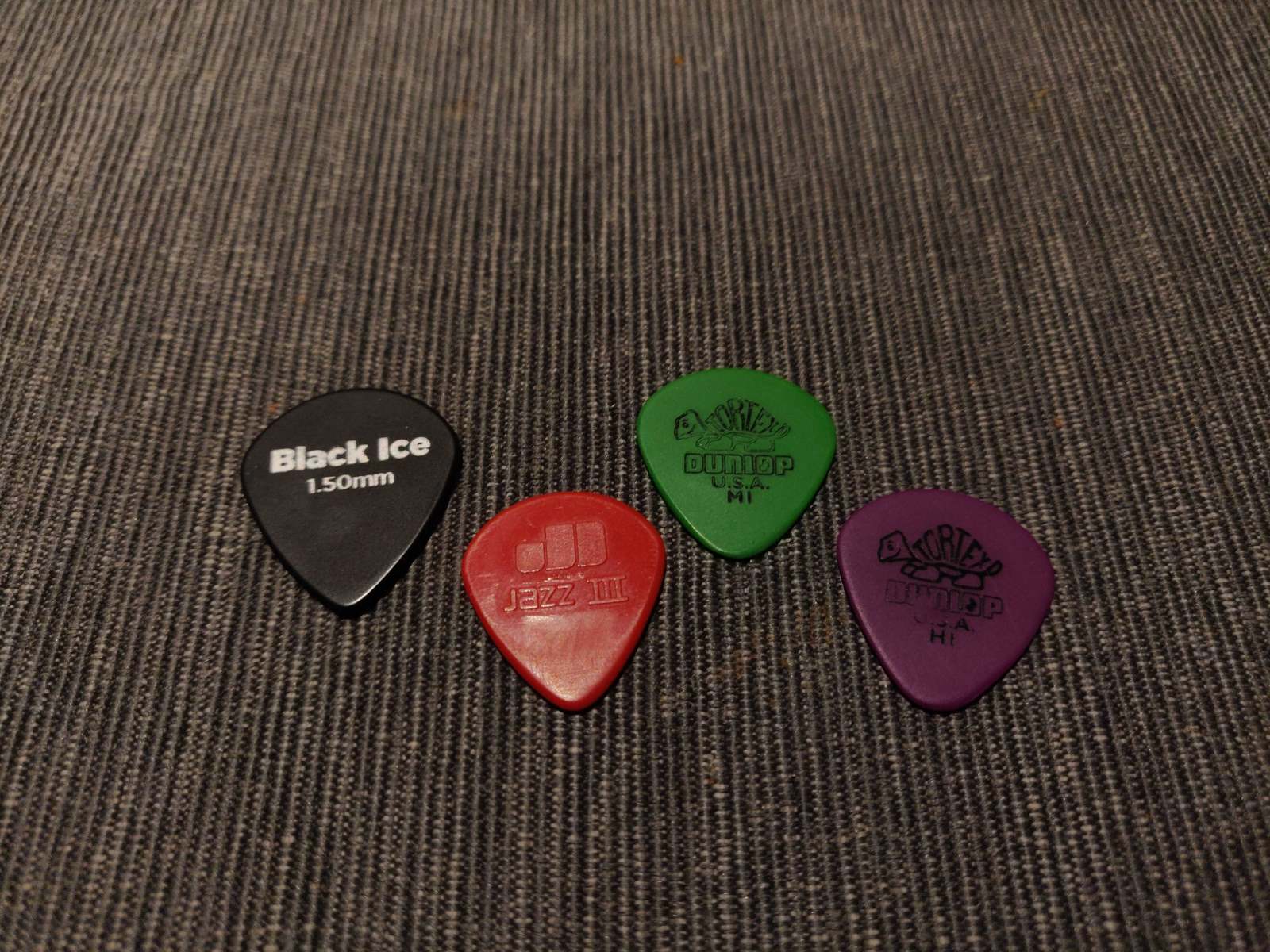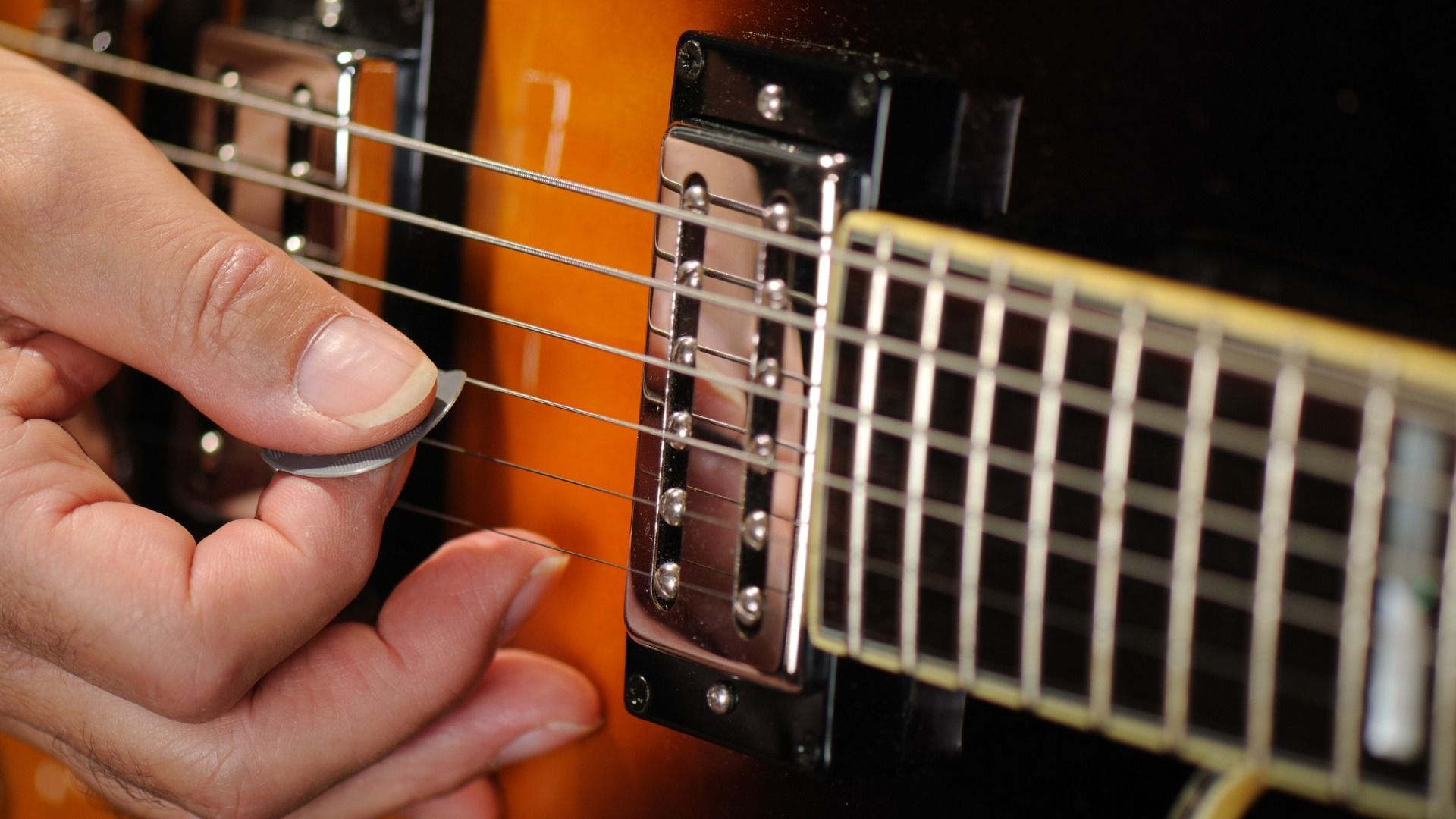

Jazz
Why Are Jazz Picks So Small
Modified: January 22, 2024
Discover why jazz picks are so small and how this unique size enhances the distinctive sound and style of jazz guitar playing. Explore the significance of jazz picks in improvisation and the intricacies of jazz music.
(Many of the links in this article redirect to a specific reviewed product. Your purchase of these products through affiliate links helps to generate commission for AudioLover.com, at no extra cost. Learn more)
Table of Contents
- Introduction
- The History of Jazz Picks
- The Importance of Pick Size in Jazz
- Jazz Picks vs. Picks in Other Music Genres
- The Advantages and Disadvantages of Small Jazz Picks
- Famous Jazz Guitarists and Their Preferences for Small Picks
- Techniques and Styles that Benefit from Small Jazz Picks
- Tips for Choosing the Right Jazz Pick Size
- Conclusion
Introduction
Jazz music has a rich and extensive history, characterized by its unique improvisation, complex harmonies, and syncopated rhythms. One aspect that often goes unnoticed but plays a crucial role in shaping the sound of jazz is the pick size used by guitarists. Unlike other music genres where picks can vary in size, jazz guitarists tend to favor small picks.
In this article, we will delve into the world of jazz picks and explore why they are so small. We will uncover the historical significance of pick size in jazz, the importance of pick size in shaping the jazz sound, and how small jazz picks compare to picks used in other music genres. Furthermore, we will discuss the advantages and disadvantages of small jazz picks and explore the preferences of famous jazz guitarists when it comes to pick size. Lastly, we will provide tips for choosing the right jazz pick size to enhance your playing style.
So, if you’re a jazz enthusiast curious about the significance of pick size in jazz or a guitarist looking to improve your jazz playing, join us on this exploration of why jazz picks are so small.
The History of Jazz Picks
The origins of jazz picks can be traced back to the early days of jazz music in the late 19th and early 20th centuries. During this time, guitarists in jazz bands and orchestras primarily used their fingers or thumb to strum or pluck the strings. However, as the genre evolved and the demand for a louder and more articulate sound increased, guitarists began experimenting with various tools to enhance their playing.
The first picks used by early jazz guitarists were typically made of ivory, bone, or tortoiseshell. These picks were larger in size and had a rounded teardrop shape, similar to picks used in other music genres. As jazz music gained popularity and more guitarists embraced the genre, the need for a pick that provided greater control and precision became evident.
In the 1930s, a guitarist named Charlie Christian emerged as a prominent figure in jazz and played a crucial role in shaping the sound of jazz guitar. Christian favored a small, triangular-shaped pick made of celluloid, a material that was readily available at the time. He found that the small pick size allowed for increased dexterity and precision, enabling him to execute the fast-paced and intricate single-note lines that became synonymous with jazz guitar playing.
Christian’s innovative use of a small pick influenced countless jazz guitarists who followed in his footsteps. As the decades passed, small picks became the norm in the jazz community, with many guitarists adopting the approach to achieve the desired jazz sound.
Today, small jazz picks are typically made of materials like nylon, Delrin, or celluloid. They are characterized by their sharp, pointed tip, which facilitates cleaner and more accurate string articulation. The small size of these picks also allows for greater control when playing complex jazz chord voicings and intricate melodic lines.
The evolution of jazz picks mirrors the evolution of jazz music itself. As the genre progressed and musicians pushed the boundaries of the artform, the need for specialized tools, such as small picks, grew. The history of jazz picks is a testament to the constant quest for musical innovation and the desire to shape the sound of jazz guitar.
The Importance of Pick Size in Jazz
Pick size plays a crucial role in shaping the tone, technique, and overall sound of a jazz guitarist. While it may seem like a small detail, the size of a jazz pick can greatly impact the player’s ability to achieve the desired sound and perform certain techniques.
One of the primary reasons for the preference of small picks in jazz is the need for speed and precision. Jazz guitarists often play intricate melodies and complex chord progressions, requiring quick and accurate picking. Small picks offer increased control and maneuverability, allowing guitarists to execute rapid single-note lines and navigate through complex chord voicings with ease.
Furthermore, the sharp and pointed tip of small jazz picks facilitates a crisper attack and cleaner string articulation. This is particularly important in jazz where clarity and distinctiveness of each note are highly valued. The smaller surface area of the pick tip allows for greater precision in striking the strings, resulting in a more defined and nuanced sound.
Jazz music is known for its rich harmonies, and small picks aid in achieving the desired tone. The focused attack and clarity provided by smaller picks allow the guitarist to bring out the individual notes in complex jazz chords, emphasizing the intricate harmonies within the music. Additionally, the smaller pick size can contribute to a more dynamic and expressive playing style, as it allows for subtle variations in pick angle and attack.
Another important aspect of pick size in jazz is the control it provides over the tone. By using a small pick, guitarists can control the amount of pick attack and brightness in their playing. Jazz guitarists often strive for a balanced and warm tone that allows the instrument to blend smoothly with the rest of the ensemble. The small pick size helps achieve this by reducing excessive brightness or harshness in the sound, resulting in a more mellow and refined jazz tone.
Overall, the size of a jazz pick directly influences the technique, tone, and expressiveness of the guitarist. With its emphasis on speed, precision, and clarity, jazz music demands a pick choice that allows for intricate playing styles and nuanced tonal control. Small picks have become the preferred choice for jazz guitarists seeking to achieve the signature jazz sound and navigate the complexity of the genre.
Jazz Picks vs. Picks in Other Music Genres
When it comes to pick size, jazz picks often stand in contrast to picks used in other music genres. While there is no hard and fast rule about which pick size is “better,” the choice of pick size largely depends on the specific needs and playing styles of musicians within each genre.
In other music genres like rock, blues, and country, larger picks are commonly used. These picks offer a broader surface area and provide more power and attack when striking the strings. They are favored by guitarists who prioritize a heavier, more aggressive sound and require greater strength and intensity in their playing.
On the other hand, jazz guitarists typically opt for smaller picks. The smaller size allows for increased control and agility, which are essential for executing complex jazz chord voicings, intricate melodies, and lightning-fast single-note lines. Jazz picks’ sharp and pointed tip allows for precise string articulation, giving each note a distinct, clean attack.
Furthermore, the tonal characteristics sought by jazz guitarists differ from those in other genres. Jazz emphasizes a warm and balanced tone that blends well with other instruments in an ensemble setting. The small picks bring out the intricate harmonies and allow for subtle tonal variations, resulting in a more refined and mellow jazz sound.
It’s worth noting that there are exceptions and variations within each genre when it comes to pick size preferences. Some rock, blues, or country guitarists may still opt for smaller picks for jazzier passages or when they require greater control and finesse in their playing. Similarly, some jazz guitarists may occasionally use larger picks for certain effects or when a more aggressive sound is desired.
Ultimately, the choice of pick size is a personal preference and should align with the musical style and requirements of the guitarist. While jazz picks tend to be smaller and offer greater precision and control, picks used in other genres emphasize power, intensity, and a different tonal character. The diversity in pick sizes caters to the wide range of musical expressions and playing techniques found across different music genres.
The Advantages and Disadvantages of Small Jazz Picks
Using small jazz picks offers a range of advantages and disadvantages for guitarists in the jazz genre. These specific advantages and disadvantages should be considered when choosing a pick size that aligns with your playing style and musical preferences.
One of the primary advantages of small jazz picks is the increased control and precision they provide. The smaller size allows for finer movements and dexterity, making it easier to navigate through complex chord voicings and intricate melodic lines. This precision is crucial in jazz, where clarity and articulation of each note are highly valued.
Small picks also promote speed and accuracy in playing. They enable guitarists to execute rapid single-note lines with ease, contributing to the dynamic and improvisational nature of jazz music. The reduced surface area of the pick tip allows for quicker string strikes, facilitating faster picking techniques such as alternate picking and sweep picking.
Furthermore, the sharp and pointed tip of small jazz picks facilitates a cleaner and crisper attack on the strings. This results in enhanced string articulation, allowing for a more defined and nuanced sound. Jazz guitarists can achieve greater clarity in playing complex jazz chord voicings and bring out the individual notes within them.
However, small jazz picks do come with some disadvantages. The reduced size may require an adjustment period for guitarists who are used to playing with larger picks. It may take time to adapt to the smaller surface area and find a comfortable grip that provides sufficient control without feeling cramped or restricted.
Additionally, small picks may not be suitable for guitarists who prefer a heavier and aggressive playing style. The smaller pick size can result in a softer attack, which may not produce the desired intensity for certain genres or musical passages. It is important to consider the specific tone and dynamics you are aiming for and whether a smaller pick can adequately achieve that.
Despite these disadvantages, the benefits of small jazz picks often outweigh the drawbacks for guitarists in the jazz genre. The increased precision, control, speed, and clean articulation they offer align well with the technical demands and tonal characteristics valued in jazz music. However, it is essential to experiment and find the pick size that feels most comfortable and suits your individual playing style and musical goals.
Famous Jazz Guitarists and Their Preferences for Small Picks
When it comes to small jazz picks, many famous jazz guitarists have embraced their advantages and made them an integral part of their playing style. These guitarists have found that small picks offer them the control, precision, and tone they desire for their jazz performances.
One iconic jazz guitarist known for his use of small picks is Joe Pass. Pass was widely recognized for his virtuosic technique and ability to play intricate, rapid lines. He favored small picks as they allowed him to execute his lightning-fast single-note runs and navigate through complex chord progressions with ease. The precision and control provided by small picks were essential for Pass’s highly articulate playing style.
Another legendary jazz guitarist, Wes Montgomery, was also known to prefer small picks. Montgomery’s smooth, melodic playing style and precise note articulation were aided by the small pick size. He could effortlessly blend single-note lines with chordal accompaniment, and the small pick allowed him to maintain clarity and control in his playing.
Pat Metheny, an influential figure in modern jazz, is another guitarist who has expressed a preference for small picks. Metheny’s versatility and expansive repertoire make use of various techniques, from delicate fingerpicking to fast-paced improvisation. The smaller pick size grants him the finesse and precision necessary to achieve his desired tonal palette and execute his intricate musical ideas.
Other notable jazz guitarists known for using small picks include Jim Hall, John Scofield, and Kurt Rosenwinkel. Each of these guitarists has incorporated small picks into their playing style to achieve the unique sound and technique associated with jazz music.
It’s important to note that while many famous jazz guitarists prefer small picks, there are exceptions. Some jazz guitarists, like John Abercrombie and Mike Stern, have been known to use larger picks at times, particularly for a heavier or more aggressive sound. These variations in pick size preference showcase the individuality and personal preferences of each guitarist.
Ultimately, the preferences of famous jazz guitarists for small picks highlight the advantages they offer in terms of control, precision, and allowing for the unique playing techniques and tonal characteristics desired in jazz music. Aspiring jazz guitarists can take inspiration from these legends and explore the benefits of small picks in their own musical journeys.
Techniques and Styles that Benefit from Small Jazz Picks
The use of small jazz picks offers several advantages for specific techniques and styles commonly found in jazz music. These techniques and styles benefit greatly from the precision, control, and tonal qualities provided by small picks.
One technique that is particularly well-suited to small jazz picks is alternate picking. Alternate picking involves alternating the downstroke and upstroke of the pick in a consistent pattern. The small size of jazz picks allows for quick and accurate string strikes, enabling guitarists to execute rapid-fire passages with ease and clarity. This technique is commonly used in jazz improvisation, where musicians need to play fast and precise lines with fluidity.
Another technique that benefits from small jazz picks is hybrid picking. Hybrid picking combines the use of a pick with the fingers of the picking hand. The smaller size of jazz picks allows guitarists to seamlessly transition between using the pick and their fingers, giving them greater control over dynamics and accentuation. Hybrid picking is often used in jazz comping, where guitarists play chords and melodies simultaneously, allowing for a more nuanced and textured sound.
Jazz guitarists frequently employ chord melody arrangements, where they play both chord voicings and a melody simultaneously. Small picks enhance the ability to cleanly articulate individual notes within complex chord voicings. This precision and control allow jazz guitarists to bring out the nuances of the harmonies and create a distinct voice for each note in the chord melody arrangement.
Styles within jazz that particularly benefit from small jazz picks include bebop and gypsy jazz. Bebop, with its rapid and intricate melodic lines, requires the speed and precision that small picks provide. The small size enhances the clarity and articulation needed to execute the complex improvisations that bebop is characterized by.
In gypsy jazz, a style made famous by Django Reinhardt, small picks contribute to the sharp and percussive sound associated with this genre. The clean attack facilitated by small picks helps to emphasize the spirited and rapid-fire lines that are a hallmark of gypsy jazz.
It’s important to note that while small jazz picks are advantageous for these techniques and styles, they are not exclusive to them. Jazz guitarists may find that small picks enhance their playing in a variety of musical contexts, allowing for greater control and precision regardless of the specific technique or style.
Ultimately, the technique and style choices of a jazz guitarist will dictate the pick size that best suits their needs. Small jazz picks offer precision, control, and tonal characteristics that greatly enhance techniques such as alternate picking and hybrid picking, as well as the distinctive styles found within jazz music.
Tips for Choosing the Right Jazz Pick Size
Choosing the right jazz pick size is a personal decision that depends on various factors, including playing style, technique, and personal preference. Here are some useful tips to consider when selecting a jazz pick size:
- Experiment and try different sizes: Start by experimenting with a range of pick sizes, including small, medium, and larger picks. This will help you understand the differences in feel, control, and tone that each size offers. Don’t be afraid to try picks outside the traditional jazz pick size range, as you might find unexpected benefits in different sizes.
- Consider your playing technique: Reflect on your playing technique and the specific techniques you frequently use in your jazz playing. If you rely heavily on fast runs, intricate melodies, and complex chord voicings, a smaller pick may provide the precision and control necessary for these techniques.
- Balance speed and power: Assess the balance between speed and power in your playing style. If you lean more towards the fast and intricate side of jazz playing, a smaller pick may be the right choice. However, if you often require more power and intensity in your playing, you might consider a slightly larger pick that provides more attack and volume.
- Consider tonal preferences: Think about the tonal qualities you desire in your jazz playing. If you value a mellow and warm tone with an emphasis on clarity and articulation, a smaller pick can help you achieve that. On the other hand, if you prefer a more aggressive and bright sound with a stronger attack, a larger pick might be a better fit.
- Take comfort into account: Pay attention to the comfort and feel of the pick in your hand. It should be a natural extension of your playing technique and not cause tension or discomfort. Play with different sizes and shapes to find the pick that feels most comfortable and allows for fluid movement.
- Seek advice and recommendations: Seek advice from fellow jazz guitarists, teachers, or professionals in music stores. They can provide insights based on their experiences and help guide you in finding the right pick size for your jazz playing.
Remember that there is no definitive “right” or “wrong” pick size for jazz. It’s a matter of finding what works best for you and aligns with your musical goals and preferences. Be open to experimentation and don’t be afraid to revisit your pick size choice as your playing style evolves. Ultimately, the right jazz pick size is the one that allows you to express yourself fully and enjoy the process of making music.
Conclusion
In conclusion, the size of a jazz pick plays a significant role in shaping the sound, technique, and overall playing experience of jazz guitarists. Small jazz picks have become the preferred choice for many jazz guitarists due to their numerous advantages. They offer increased control, precision, and speed, allowing guitarists to navigate through complex chord progressions, execute rapid single-note lines, and achieve clean string articulation. The sharp and pointed tip of small picks contributes to a distinct and nuanced sound, emphasizing the clarity of each note and the intricacies of jazz harmonies.
While small picks are often associated with jazz, it is important to acknowledge that pick size preferences can vary among individual guitarists and across different music genres. Picks of different sizes have their own unique advantages and may be suitable for specific playing styles and techniques. It is crucial for each guitarist to explore and experiment with different pick sizes to find the one that aligns with their playing style, musical preferences, and technical requirements.
Whether you are a jazz guitarist seeking greater precision and control or someone interested in the nuances of jazz music, understanding the significance of pick size in jazz can elevate your appreciation for the genre. Take the time to explore and consider the historical context, techniques, and preferences of famous jazz guitarists. Armed with this knowledge, you can make an informed choice when selecting a jazz pick that enhances your playing style and allows you to express your musical ideas with clarity and precision.
In the end, the choice of jazz pick size is a personal one, and finding the right pick size is an ongoing journey as your playing evolves. Embrace the experimentation, appreciate the nuances, and enjoy the process of discovering the perfect jazz pick size that takes your jazz guitar playing to new heights.











